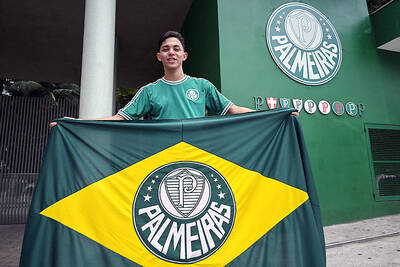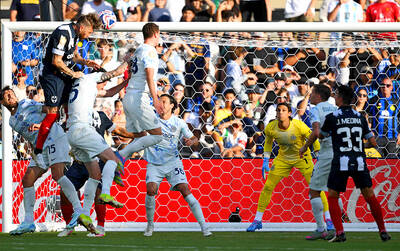On a recent minus 12°C night in this Twin Cities suburb, two men’s teams skated and stick-handled and zeroed in on goal.
But they were not playing hockey. The rink was 110 yards long and 60 yards wide, about the size of a soccer field. Each side had 11 players, and they passed and shot a small orange ball, not a puck, toward the 7-foot-high, 11-foot-wide net.
The game was bandy, a forerunner of hockey that dates back 200 years, and the US national team was playing its last scrimmage before heading to Moscow for the annual world championship, which ends tomorrow. Enthusiasts of bandy, which has similarities to field hockey and soccer, are fighting for it to become an Olympic sport.
BOOZY FEET
“I used to think we were hardy in Minnesota, but one year we played in Arkhangelsk, up near the White Sea, and it was 38 below [minus 39°C],” said Chris Halden, a 53-year-old real estate appraiser, player/coach and member of the team since its inception in 1981. “The Russians told us to soak our feet in buckets of vodka at halftime — supposedly it would keep us warm. Some guys did it. I told them they smelled like booze.”
The Guidant John Rose Oval in Roseville is the only full-size outdoor bandy rink in the US. Except for when the Canadian national team clears off its natural-ice rink on a lake in Winnipeg, this is the only place bandy is played in North America.
The sport is little known on this continent, but in Sweden it is a part of the national culture, drawing 30,000 or more to the annual championship game.
In Russia more than a million people play bandy, with a professional league that pays top players up to US$500,000 a year to play in crumbling Stalin-era outdoor stadiums before crowds of 200 to 15,000.
“I’ve been very fortunate to experience all of that,” said Chris Middlebrook, who started as a player in 1981 and divides time between his law career and being the US team’s head coach. “Through bandy, I’ve been able to meet people and see places I’d never otherwise have seen: Siberia while the Cold War was still on, Budapest, Helsinki, full stadiums in the dead of winter cheering us on like rock stars. And then I come back home, and almost no one knows what this sport is.”
In the US, perhaps 300 men, 50 women and 200 youngsters play bandy. All of them live in the Twin Cities, except for a handful from Duluth who drive down on weekends.
Most of the national team players took up bandy after playing college hockey, often because the rules governing contact resemble those of soccer, shoulder-to-shoulder challenges only. Full-on body checking is prohibited.
“After I graduated I played in men’s hockey leagues, and I always came home bleeding,” said Rick Haney, a former Harvard hockey player and a captain of the American bandy team. “Then I tried bandy, and as soon as I stepped out on the ice I knew I was home.”
STAMINA COUNTS
The appeal of bandy goes beyond safety considerations. The game requires more skating stamina than hockey because there is more ice to cover (11km to 18km per 90-minute game) and far fewer substitutions.
It also requires the ability to maneuver at high speed. Jere Lehtinen, the longtime forward for the Dallas Stars and Finland, is among the Nordic NHL players who have credited their success in hockey to the skating skills they learned as youth bandy players.
The International Olympic Committee (IOC) recognizes the sport because the requisite 25 nations have bandy federations (about 14 actually play regularly), but it does not have sufficient standing for the Olympics. The Russians, who will stage the 2014 Olympics in Sochi, are pushing the IOC to give bandy some role at those Games.
The earliest record of a bandy club, Bury Fen in England, dates to 1813. In those days the fens of East Anglia regularly froze in winter, giving rise to a lively culture of distance skating and bandy. In 1853, a game, referred to as “hockey on the ice,” was played at Windsor Castle with Prince Albert in goal. One of the earliest soccer clubs, and one still playing today, was founded in 1865 as Nottingham Forest Football and Bandy Club.
The rules of bandy were codified in 1882, seven years after the rules for hockey were codified in Montreal. While hockey spread across Canada and the northern US, bandy spread across Northern Europe, becoming a popular wintertime game from the Netherlands to Prague to St Petersburg, Russia.
FADEAWAY
But by the late 1920s, warmer winters and the more manageable logistics of hockey — with about half the players on a rink about half the size — took their toll. Bandy disappeared from England and the Netherlands, and the Czechs switched to hockey.
The last holdouts were the Nordic countries, and especially Soviet Russia. Dinamo Moscow was that nation’s top bandy club in 1946 when it staged an exhibition of “Canadian hockey,” which caught on quickly. The Soviets became so good at hockey so fast not because of any government-backed effort, as Westerners tend to believe, but because Russians had played bandy through long, cold winters for decades.
Bandy, known as ball hockey or Russian hockey, is still popular there today, mainly in Arctic cities like Arkhangelsk and across Siberia. But this year’s world championship is being staged in Moscow at a six-year-old indoor stadium, the 10,000-seat Krylatskoye Arena.
Russia has won 23 championships, and Sweden, the defending champion, has nine. They could meet in tomorrow’s final if Russia beats Kazakhstan and Sweden defeats Finland in today’s semi-finals.

Brazil has four teams, more than any other country, in the expanded Club World Cup that kicked off yesterday in the US, but for SE Palmeiras, the competition holds a special meaning: winning it would provide some redemption. Under coach Abel Ferreira since 2020, Palmeiras lifted two Copa Libertadores titles, plus Brazilian league, cup and state championships. Even before Ferreira, it boasted another South American crown and 11 league titles. The only major trophy missing is a world champions’ title. Other Brazilian clubs like Fluminense FC and Botafogo FR, also in the tournament, have never won it either, but the problem for Palmeiras

Lionel Messi drew vast crowds and showed flashes of his brilliance when his Inter Miami side were held to a goalless draw by African giants Al-Ahly as the revamped FIFA Club World Cup got off to a festive start on Saturday. Fans showed up en masse for the Group A clash at the Hard Rock Stadium, home to the NFL’s Miami Dolphins, but Messi could not fully deliver, his best chance coming through a last-second attempt that was deflected onto the crossbar. Inter Miami next face FC Porto on Thursday in Atlanta, while Al-Ahly, who benefited from raucous, massive support, are to

Sergio Ramos on Tuesday outfoxed two Inter players and artfully headed home the first goal for Monterrey at the FIFA Club World Cup. The 39-year-old Ramos slipped through the penalty area for the score just as he did for so many years in the shirts of Real Madrid and Spain’s national team, with whom he combined smarts, timing and physicality. Ramos’ clever goal and his overall defensive play at the Rose Bowl were major factors in Monterrey’s impressive 1-1 draw against the UEFA Champions League finalists in the clubs’ first match of the tournament. “There is always a joy to contribute to the

Los Angeles Dodgers two-way star Shohei Ohtani on Monday wobbled through a 28-pitch first inning at home against the San Diego Padres in his first appearance on the mound since August 2023. Scheduled to throw as many as two innings, Ohtani went a single frame while allowing one run on two hits. He did not issue a walk nor strike out a batter. “Not quite happy with the results overall, but the takeaway for me is that I feel good enough to be able to make the next outing,” Ohtani said of his pitching performance. Ohtani still wound up with a positive impact